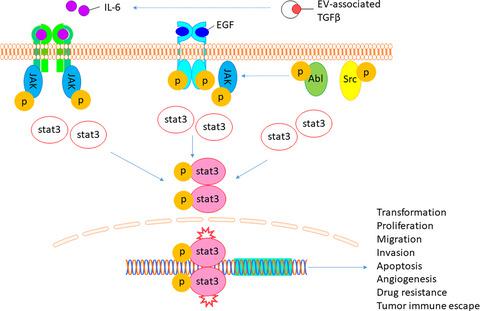当前位置:
X-MOL 学术
›
Cell Prolif.
›
论文详情
Our official English website, www.x-mol.net, welcomes your
feedback! (Note: you will need to create a separate account there.)
STAT3 and its targeting inhibitors in osteosarcoma
Cell Proliferation ( IF 5.9 ) Pub Date : 2020-12-31 , DOI: 10.1111/cpr.12974 Yun Liu 1, 2, 3 , Shijie Liao 2, 3, 4 , Samuel Bennett 2 , Haijun Tang 5 , Dezhi Song 2, 3 , David Wood 2 , Xinli Zhan 1, 2, 3 , Jiake Xu 2
Cell Proliferation ( IF 5.9 ) Pub Date : 2020-12-31 , DOI: 10.1111/cpr.12974 Yun Liu 1, 2, 3 , Shijie Liao 2, 3, 4 , Samuel Bennett 2 , Haijun Tang 5 , Dezhi Song 2, 3 , David Wood 2 , Xinli Zhan 1, 2, 3 , Jiake Xu 2
Affiliation

|
Signal transducer and activator of transcription 3 (STAT3) is one of seven STAT family members involved with the regulation of cellular growth, differentiation and survival. STAT proteins are conserved among eukaryotes and are important for biological functions of embryogenesis, immunity, haematopoiesis and cell migration. STAT3 is widely expressed and located in the cytoplasm in an inactive form. STAT3 is rapidly and transiently activated by tyrosine phosphorylation by a range of signalling pathways, including cytokines from the IL-6 family and growth factors, such as EGF and PDGF. STAT3 activation and subsequent dimer formation initiates nuclear translocation of STAT3 for the regulation of target gene transcription. Four STAT3 isoforms have been identified, which have distinct biological functions. STAT3 is considered a proto-oncogene and constitutive activation of STAT3 is implicated in the development of various cancers, including multiple myeloma, leukaemia and lymphomas. In this review, we focus on recent progress on STAT3 and osteosarcoma (OS). Notably, STAT3 is overexpressed and associated with the poor prognosis of OS. Constitutive activation of STAT3 in OS appears to upregulate the expression of target oncogenes, leading to OS cell transformation, proliferation, tumour formation, invasion, metastasis, immune evasion and drug resistance. Taken together, STAT3 is a target for cancer therapy, and STAT3 inhibitors represent potential therapeutic candidates for the treatment of OS.
中文翻译:

STAT3 及其靶向抑制剂在骨肉瘤中的作用
信号转导和转录激活因子 3 (STAT3) 是参与调节细胞生长、分化和存活的七个 STAT 家族成员之一。STAT 蛋白在真核生物中是保守的,对胚胎发生、免疫、造血和细胞迁移的生物学功能很重要。STAT3 广泛表达并以非活性形式位于细胞质中。STAT3 被一系列信号通路(包括来自 IL-6 家族的细胞因子和生长因子(例如 EGF 和 PDGF))的酪氨酸磷酸化迅速和瞬时激活。STAT3 激活和随后的二聚体形成启动 STAT3 的核易位以调节靶基因转录。已鉴定出四种具有不同生物学功能的 STAT3 同种型。STAT3 被认为是原癌基因,STAT3 的组成型激活与多种癌症的发展有关,包括多发性骨髓瘤、白血病和淋巴瘤。在这篇综述中,我们重点关注 STAT3 和骨肉瘤 (OS) 的最新进展。值得注意的是,STAT3 过度表达并与 OS 的不良预后相关。OS中STAT3的组成性激活似乎上调了靶癌基因的表达,导致OS细胞转化、增殖、肿瘤形成、侵袭、转移、免疫逃避和耐药性。总之,STAT3 是癌症治疗的靶点,STAT3 抑制剂代表了治疗 OS 的潜在候选药物。我们关注 STAT3 和骨肉瘤 (OS) 的最新进展。值得注意的是,STAT3 过度表达并与 OS 的不良预后相关。OS中STAT3的组成性激活似乎上调了靶癌基因的表达,导致OS细胞转化、增殖、肿瘤形成、侵袭、转移、免疫逃避和耐药性。总之,STAT3 是癌症治疗的靶点,STAT3 抑制剂代表了治疗 OS 的潜在候选药物。我们关注 STAT3 和骨肉瘤 (OS) 的最新进展。值得注意的是,STAT3 过度表达并与 OS 的不良预后相关。OS中STAT3的组成性激活似乎上调了靶癌基因的表达,导致OS细胞转化、增殖、肿瘤形成、侵袭、转移、免疫逃避和耐药性。总之,STAT3 是癌症治疗的靶点,STAT3 抑制剂代表了治疗 OS 的潜在候选药物。
更新日期:2020-12-31
中文翻译:

STAT3 及其靶向抑制剂在骨肉瘤中的作用
信号转导和转录激活因子 3 (STAT3) 是参与调节细胞生长、分化和存活的七个 STAT 家族成员之一。STAT 蛋白在真核生物中是保守的,对胚胎发生、免疫、造血和细胞迁移的生物学功能很重要。STAT3 广泛表达并以非活性形式位于细胞质中。STAT3 被一系列信号通路(包括来自 IL-6 家族的细胞因子和生长因子(例如 EGF 和 PDGF))的酪氨酸磷酸化迅速和瞬时激活。STAT3 激活和随后的二聚体形成启动 STAT3 的核易位以调节靶基因转录。已鉴定出四种具有不同生物学功能的 STAT3 同种型。STAT3 被认为是原癌基因,STAT3 的组成型激活与多种癌症的发展有关,包括多发性骨髓瘤、白血病和淋巴瘤。在这篇综述中,我们重点关注 STAT3 和骨肉瘤 (OS) 的最新进展。值得注意的是,STAT3 过度表达并与 OS 的不良预后相关。OS中STAT3的组成性激活似乎上调了靶癌基因的表达,导致OS细胞转化、增殖、肿瘤形成、侵袭、转移、免疫逃避和耐药性。总之,STAT3 是癌症治疗的靶点,STAT3 抑制剂代表了治疗 OS 的潜在候选药物。我们关注 STAT3 和骨肉瘤 (OS) 的最新进展。值得注意的是,STAT3 过度表达并与 OS 的不良预后相关。OS中STAT3的组成性激活似乎上调了靶癌基因的表达,导致OS细胞转化、增殖、肿瘤形成、侵袭、转移、免疫逃避和耐药性。总之,STAT3 是癌症治疗的靶点,STAT3 抑制剂代表了治疗 OS 的潜在候选药物。我们关注 STAT3 和骨肉瘤 (OS) 的最新进展。值得注意的是,STAT3 过度表达并与 OS 的不良预后相关。OS中STAT3的组成性激活似乎上调了靶癌基因的表达,导致OS细胞转化、增殖、肿瘤形成、侵袭、转移、免疫逃避和耐药性。总之,STAT3 是癌症治疗的靶点,STAT3 抑制剂代表了治疗 OS 的潜在候选药物。











































 京公网安备 11010802027423号
京公网安备 11010802027423号